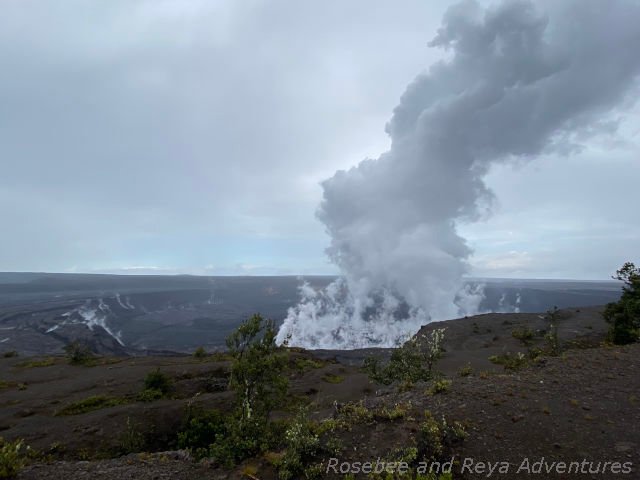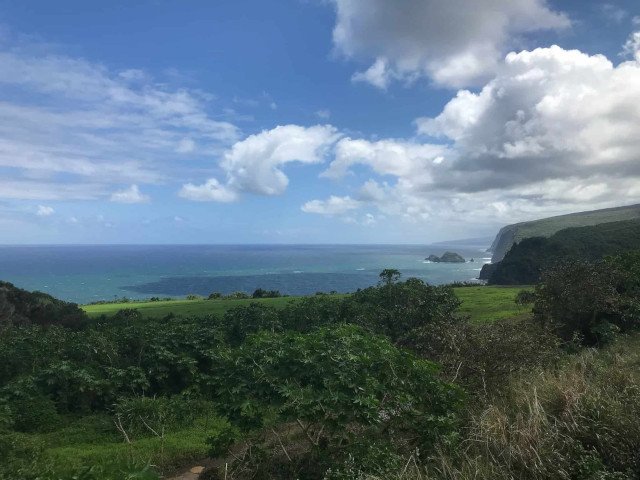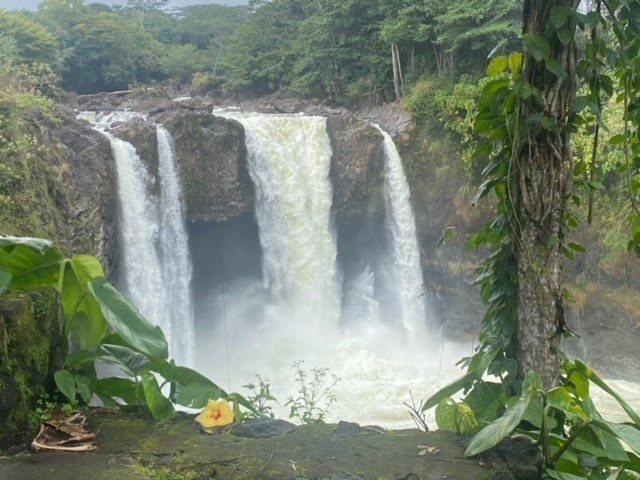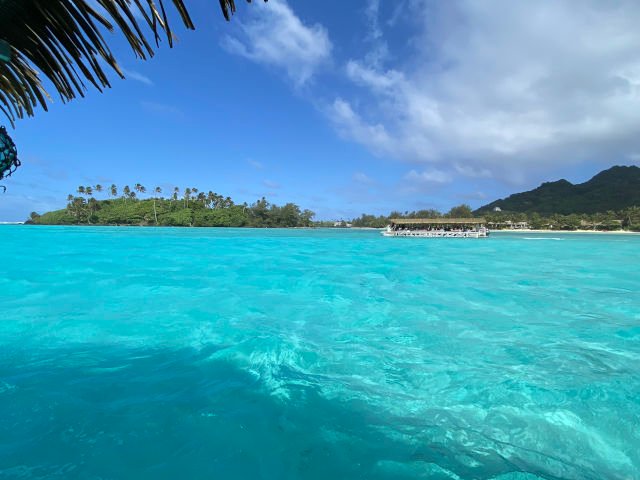The Cook Islands are a South Pacific archipelago with breathtaking views of pristine turquoise waters, white sand beaches, and lush jungle forests. The Cook Islands are a perfect destination to consider when planning a vacation to the South Pacific. Many activities are available to tourists. Sport fishing, kayaking, paddle boarding, kite surfing, and hiking are some of the activities you will find on Rarotonga. Or you might opt to relax on a beach in a lounge chair while enjoying the picturesque view. There is something for everyone in the Cook Islands. It is a destination that should not be overlooked when deciding where to take a holiday in the South Pacific. Researching a destination before embarking on a new one is always a good idea. Here are the top things you should know when planning your visit to the Cook Islands.
Where are the Cook Islands
The Cook Islands is a nation of 15 islands. Its 15 islands and atolls cover a sea area of 2.2 million square kilometers between America Samoa and French Polynesian. The Cook Islands and are located in the area generally known as the South Pacific. The Cook Islands are just shy of crossing the dateline. The date will not change if you are flying from the west, such as from the USA. If you are flying from the east from countries such as Australia or New Zealand, you will cross the date line and go back one day.
Of the 15 islands that comprise the Cook Islands, Rarotonga is the largest and most populated of the Islands. Rarotonga is surrounded by a coral reef. Rarotonga has shallow lagoons and pristine beaches, which are perfect for snorkeling and other water sports. While there are several towns in Rarotonga, the main town is Avarua. Avarua is also the capital of the Cook Islands, where the airport is located, and where you will begin your adventure in the Cook Islands.
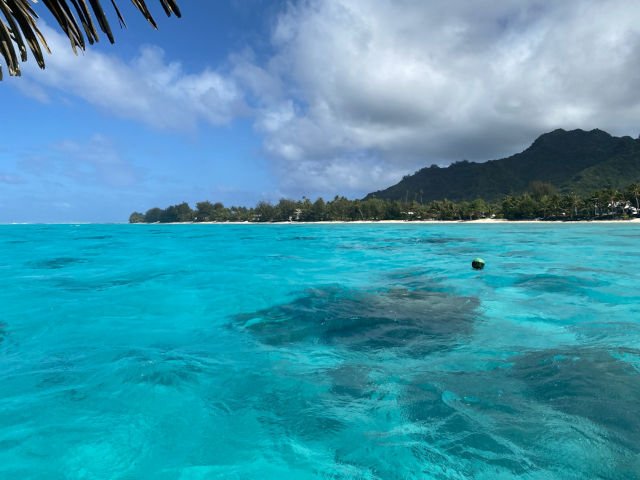
How to Get to the Cook Islands
The availability of flights is one of the important things you need to know when planning your visit to the Cook Islands. While several Air Carriers offer flights to Rarotonga, most of the flights arriving in Rarotonga arrive from surrounding countries such as New Zealand and Australia. If you are traveling to Rarotonga from the United States, only one flight arrives in Rarotonga directly from the United States. Hawaiian Airlines added a route to Rarotonga in May of 2023 and currently flies the sole route to Rarotonga directly from the United States. The current flight schedule to Rarotonga from the United States includes two weekly flights, one inbound and the other outbound. The flight to Rarotonga departs from Honolulu, arriving on Saturday night. The return flight to Honolulu departs on Sunday night, arriving in Honolulu Monday morning.
Visiting Other islands
If you would like to visit other islands, Air Rarotonga is the main airline for inter-island travel. Other Islands that you can visit are Aitutaki, Atiu, Mangaia, Manihiki, Mauke, and Mitiaro. The most visited islands are Rarotonga and Aitutaki. Aitutaki is a popular island for honeymooners. It is known as the “Pearl of the Pacific” due to its stunning lagoon, pristine turquoise waters, and lush tropical landscape. If a multi-day stay in Aitutaki is not in the plans during your trip to the Cook Islands, there are day trips to Aitutaki available.
Atiu is the third most visited island of the Cook Islands but only receives a small percentage of visitors per year. Aitu is an unspoiled paradise with a couple of accommodations available for tourists. If you are seeking a quiet and tranquil island getaway, Aitu should be in your travel plans. Whichever island you decide to visit in the Cook Islands, you will come away with an unforgettable escape in this remote paradise.
The Best Time to Plan Your Visit to the Cook Islands
When planning your visit to the Cook Islands, it is good to know that generally, any time is the best time to visit Rarotonga and the rest of the Cook Islands. The Cook Islands are also spread out over a large area of the Pacific. Therefore, the weather will differ on each island. The Cook Islands have a tropical climate, which is pleasant year-round. December marks the start of the summer season, which goes through March. The weather during this time is hotter but not unpleasant. This season is also the rainy season in the Cook Islands. However, rain on the islands could mean a shower for several minutes or for an hour or two in the morning and then sunny weather the rest of the day.
The drier months in the Cook Islands run from April to November. The weather is still warm and tropical, but there is less rainfall during this time. Due to the island’s tropical climate, this does not mean that you won’t see any rainfall during this time. The shoulder months of April, May, September, and October are also some of the best months to visit Rarotonga, as these months have a great balance between warmer days and drier skies.
Whale Watching Season in the Cook Islands
If whale watching is something you are interested in, the Cook Islands is a great place to catch a glimpse of this special mammal. When planning your visit to the Cook Islands, you might consider taking your trip during whale-watching season. The whale-watching season starts around mid-June and goes through October in the Cook Islands. During this time, you will see humpback whales around the island as they begin their migration north from Australia, New Zealand, and Antarctica. The humpback whales provide visitors with an incredible view as they are not too far off from shore and can be seen breaching from the ocean. The western part of Rarotonga is the best place to see whales; however, we were able to see many whales swimming and breaching from the ocean in the northern part of Rarotonga.
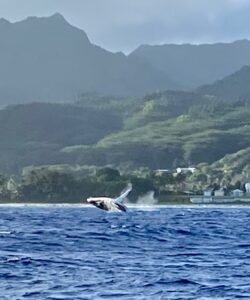
Several Things to Know to Make Your Cook Island Adventure Easier
Visiting a foreign country can be intimidating, especially if one is not familiar with the country’s customs or if one doesn’t have general information about what to expect during their visit. To make your visit easier, here are a few helpful tips that are important to know and bits of information about the Cook Islands to help you prepare for and have a more enjoyable visit.
Cook Island Greetings
Life in the Cook Islands is very relaxed and calm. You will notice immediately that Cook Islanders are very warm-hearted and kind people. There are several greetings that you will hear upon your arrival in the Cook Islands. It is a good idea to familiarize yourself with these greetings, especially the first one, as Cook Islanders are known to greet visitors warmly, and you are likely to hear these greetings shortly upon arrival in the Cook Islands.
The first greeting you will learn, which also adorns the airport entryway upon arrival, is “Kia Orana.” “Kia Orana” is used as “welcome” and “how are you,” but it means “may you live long.” Another phrase you will hear and learn is “Meitaki Ma’ata” which means thank you very much. Using “Meitaki” by itself means thank you or good. Don’t be shy to use any of these greetings. After a couple of days in the Cook Islands, you will become a pro at using these Maori greetings.
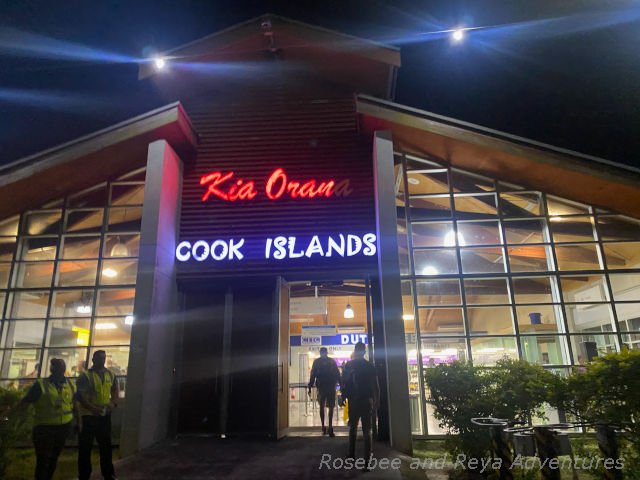
Dress Etiquette in the Cook Islands
The Cook Islands is a religious country. Therefore, there are some rules of etiquette that visitors should be aware of when visiting the Cook Islands. The dress code in the Cook Islands is generally informal. You will find most tourists wearing shorts and t-shirts, or sundresses. However, bathing suit attire should not be worn when visiting towns, churches, or villages. Bathing suit attire should be worn only when visiting beaches or when in a swimming pool. Sarongs can be used to cover up swimwear. Two-piece bikini tops should also be covered up when not on the beach or in the pool. When visiting churches, one’s attire should be modest. Women’s shoulders, as well as their knees, should be covered up.
Saturdays and Sundays in the Cook Islands
As mentioned previously, Cook Islanders are a very religious community. Some shops and restaurants are open half a day on Saturday, while other shops and restaurants are closed on Saturday to observe the Sabbath for Seventh-Day Adventists. For other Christian religions, Sundays are observed. Most retail shops and restaurants are closed on Sundays. Additionally, alcohol is not sold on Sundays. While many restaurants and shops are closed on Saturday or Sunday, you can find places to eat on both days. The Punanga Nui Market in Avarua operates Saturday morning until 12:30 PM. The Muri Night Market operates on Sunday evenings from 5:00 p.m. until 9:00 p.m. To learn more about the Punanga Nui Market in Avarua and the Muri Night Market, you can read our blog on the Top Things to Do in Rarotonga in the Cook Islands.
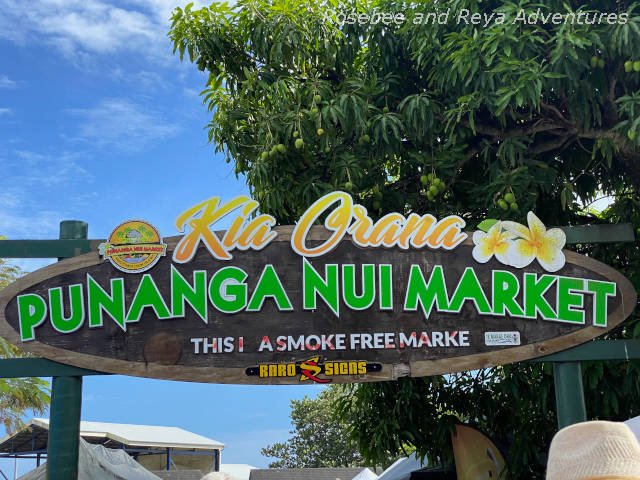
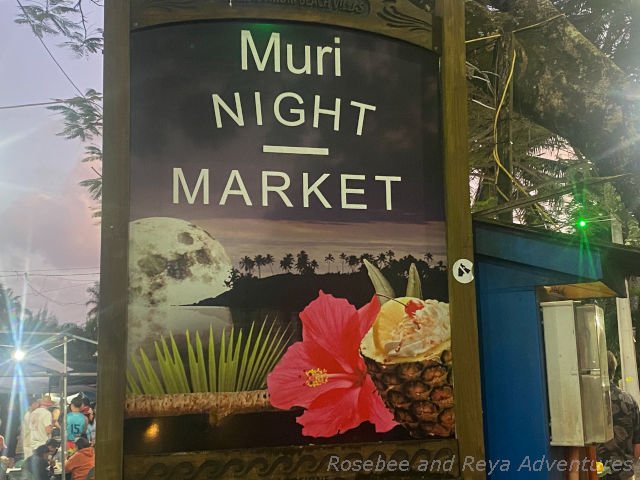
Currency Used in the Cook Islands
The currency used in the Cook Islands is the New Zealand dollar, although there is currency, such as a few coins and some notes, that are exclusive to the Cook Islands. There is a BPS (Bank of the South Pacific) ATM available at the airport for cash withdrawals, making it easy for arriving tourists to get any currency they might need. There are also many BSP and ANZ ATMs available throughout the island and in the main town of Avarua. BSP bank is open on Saturday for a few hours in the morning. Withdrawing money is generally not a problem for tourists. Most currency and travelers’ checks may be exchanged at the local banks.
The Cook Islands $3.00 Note
If you are lucky, you will come across the Cook Islands $3.00 note. The $3.00 note is popular, considered a collectible, and relatively hard to come by. The original design of the note was a Sunday street scene with shells, sea life, and a bird on the back side of the note. The design was changed in 2020, and the new $3.00 note was introduced in 2021. The new design was made by California artist Rick Welland, who painted and lived on Rarotonga for 28 years. The design is based on Welland’s painting “Ina’s Moonlit Journey,” which is on the front side of the note. The back side has a picture of a Cook Islander in his fishing canoe and the god Te-Rongo.
Cash Only Preference in the Cook Islands
While many hotels and restaurants take credit cards, the general consensus is that cash is the preferred form of payment. Tourists visiting the Cook Islands should be prepared with sufficient cash to pay for any chartered trips, food, and souvenirs. There are many vendors, stores, and eateries that are cash-only businesses. If paying by credit card, Visa and Mastercard are the most widely accepted forms of credit. Very few businesses accept American Express.
Subscribe to our Travel Newsletter!
Receive our free Packing Guide with Bonus Cruise Essentials Checklist and Waikiki Travel Guide with Map when you subscribe.
Restaurant Hours in the Cook Islands
Many restaurants close after the lunch service in order to prepare for the dinner service. Lunch service generally ends around 2:00 PM, with some restaurants closing their kitchen service at 2:30 PM or 3:00 PM. Dinner service starts around 5:00 PM or 6:00 PM. This is important to know in case you arrive from a different time zone and find yourself hungry during a time when it might be difficult to get a bite to eat. Luckily, there are places that do stay open where you can get takeaway or have a quick bite to eat. The Superbrown 24 market is open 24 hours a day and offers hot food 24 hours a day.
Availability of Filtered Drinking Water
In the Cook Islands, tap water is unsuitable for consumption and must be boiled before use. Bottled water is readily available and can be purchased from one of the local supermarkets or from your hotel. You should pack a reusable water bottle when planning your visit to the Cook Islands. A reusable water bottle will be useful as some higher-end hotels have filtered water stations for their guests. Water stations are also located throughout the island of Rarotonga to make things easier for tourists. The water from the water stations is filtered and safe to drink. There is also no charge to fill your bottles at the water stations. While the water from the tap cannot be used to drink without first boiling it, the water stations make water readily accessible to locals and tourists.
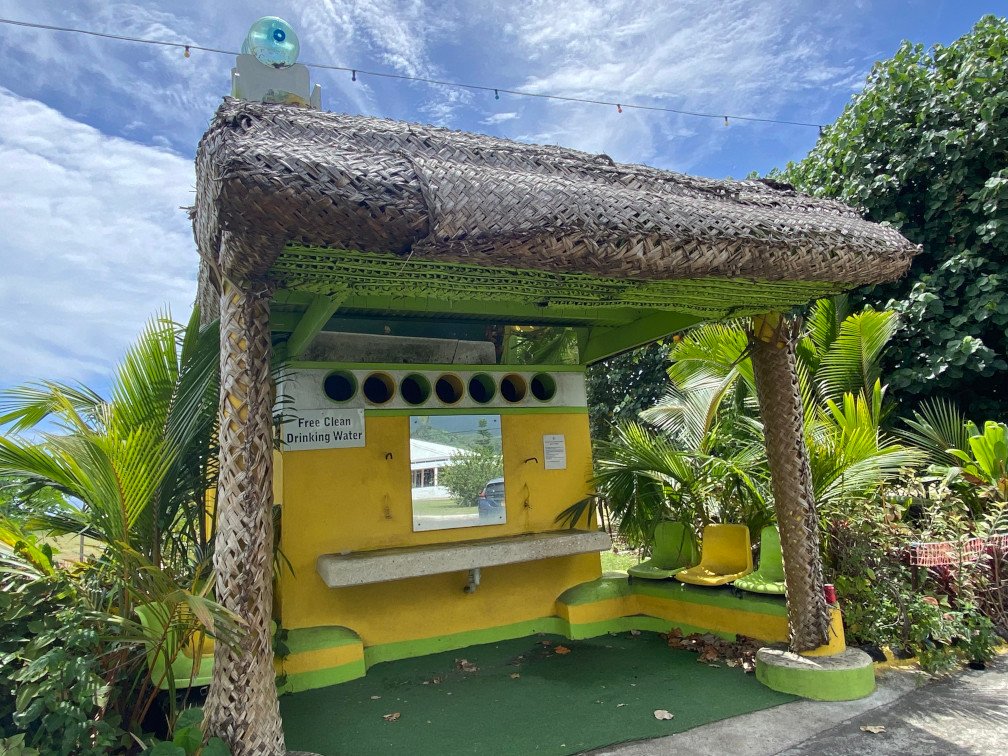
Television in the Cook Islands
There is only one television channel in the Cook Islands that airs New Zealand news and Cook Island news, as well as other local programs. If you want to watch your preferred shows while in the Cook Islands, downloading them on your device, such as your phone, iPad, or computer, is a good idea.
Beach Warning Signs
Some beach areas have a sign posted warning of possible dangerous conditions. These signs should be heeded as some, if not most, of the areas are passages with strong currents and rip tides. There aren’t many of these areas, and the signs are posted in each dangerous area but are not overly pronounced. Tourist information pamphlets with maps, which are available in many hotels, have the passages marked on the map for easy identification. Care should be taken if swimming or kayaking in these areas. Better yet, one should swim or kayak in a safer area and avoid the passages in order to prevent any problems.
Transportation in the Cook Islands
When planning your visit to the Cook Islands, you will need to consider what type of transportation you will use. Luckily, there are several options to choose from, and getting around Rarotonga is fairly easy. There are three ways to get around the island: the first two are renting a vehicle or a motor scooter, and the third and very popular option is to ride public transportation. Vehicles in the Cook Islands are driven on the left-hand side of the road. There is a motor scooter speed limit of 40 kmph. Helmets are required for motor scooters. The maximum speed limit for vehicles in Rarotonga is 40 kmph, and 50 kmph in open areas. However, there is a speed limit of 30 kmph in Avarua and Muri. The speed limit in school zones is 20 kmph.
Renting a Vehicle in the Cook Islands
Many tourists opt to rent a vehicle while on Rarotonga. Tourists can rent vehicles or motor scooters to get around the island. There are many car rental companies in Rarotonga, with some companies located close to many hotels. In order to rent a vehicle, you must be a licensed driver and over the age of 16. Driver licenses from Australia, Canada, the European Union, Japan, New Zealand, Norway, and the USA are readily accepted for renting vehicles and driving in the Cook Islands.
Renting a Motor Scooter in the Cook Islands
Scooters are a popular form of getting around town for tourists. In order to rent a scooter, one must have a motorcycle license from Australia, Canada, the European Union, Japan, New Zealand, Norway, or the USA. If you do not already have a motorcycle license in one of the accepted countries or in your home country, you can apply for a license to operate a motor scooter on Rarotonga.
Tourists who need a license can get a license to rent a scooter by visiting the police station in Avarua, taking and passing a written exam, and passing the riding exam. Riders will need to have passed the written exam prior to renting their motor scooter, as the paperwork showing the passing test results will need to be presented to the rental company. The rented scooter will also be necessary for the practical exam.
Taking your Motor Scooter Examination
The written exam has 25 questions, and you can only miss two questions on the exam. The riding exam will test your ability to operate a motor scooter. The exam is given at the police station and you will be given instructions on what you must do during the practical examination. Riders must perform certain tasks while riding their scooter during the exam. The tasks include riding down the exam driveway, stopping, placing one or both feet on the ground, and signaling for a right turn. You must also make a U-turn, perform a serpentine pattern through 12 pylons, and then stop at a stop sign. As you negotiate the pylons, putting your foot on the ground or missing a pylon is an automatic fail. If you fail the exam, you can try again the next day.
You can rent a scooter to get around town when you satisfy the testing requirements. The written test costs $20 NZD, and the riding test costs $20 NZD for a total of $40 NZD to become licensed to operate a scooter. Your motorcycle license will be valid for 31 days. When you return to the Cook Islands, you can renew your license without retesting.
Riding the Bus in Rarotonga
Riding the Bus in Rarotonga is relatively easy to negotiate. There are two main bus lines in Rarotonga. Clockwise and anti-clockwise, with each line circling the island in either a clockwise or anti-clockwise direction. It takes approximately 40 minutes to circle the island using public transportation. The bus drivers are very courteous and extremely helpful and will assist you with any questions you might have. There are many bus stops located throughout the island. As long as it is safe for the bus to stop for you at your location, you can flag down the bus and hop on.
The clockwise route operates from 7:00 a.m. to 5:00 p.m., leaving every hour on the hour from the main bus stop in Avarua. The anti-clockwise bus route operates from 8:30 a.m. to 4:30 p.m., leaving every hour on the half-hour from the main bus stop in Avarua. The night bus runs clockwise around the island from 6:00 pm to 11:00 pm. The clockwise bus is both the day bus and the night bus. Different schedules are listed for the day and night buses, which can be confusing. It is easier to remember that the clockwise bus runs from 7:00 a.m. to 11:00 p.m. It is important to note that on Sunday, the bus operates until 4:00 p.m. with only the clockwise route operating.
The cost per bus trip is $5.00 NZD; however, additional passes are available that are more cost-effective if you will be riding frequently. One of the popular options is the 10-ride concession pass for $30.00 NZD. By purchasing the 10-ride concession pass, you will save $20.00 NZD. You can share your pass with anyone in your party as long as they are with you when you board the bus.
The TransportMe Passenger App
To make things a little easier for tourists riding the bus, the Cook Islands Bus Company has an app available for download on the Apple Store or the Google Play store. The TransportMe Passenger App can be used to track the location of its buses, which will assist you in knowing how much time you have to wait for the next bus. You will need to have access to the internet to use the app. You can also check bus schedules on the Cook Islands Bus website.
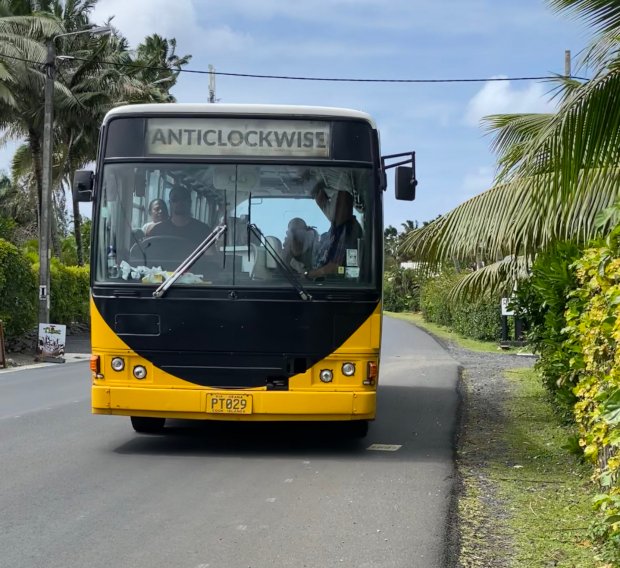
Cellular Phone Use, Data Plans and WiFi
The Cook Islands is a remote destination; thus, Cellular plans and WiFi are not readily available, especially for travelers from the United States. When planning your visit to the Cook Islands, you might need to consider that you will be disconnected during part of your time spent on the islands. However, solutions and plans are available for tourists to help them stay connected and keep in touch with family.
Vodaphone Plans for Cellular Phones
Whether or not you will have a working cell phone will depend on whether your phone is compatible with GSM and is unlocked. Nowadays, GSM is readily available on cell phones, so this should not be a problem. The real issue is that cell phone carriers do not include the Cook Islands in their international plans. Luckily, Vodaphone is available for those who want to use their cell phone on the islands. Vodaphone provides data plans and SIM cards on the Cook Islands for tourists and enables them to use their phones to keep in contact with family overseas. Your phone needs to be compatible with the GSM network and unlocked to use a different SIM card other than the card provided by your regular carrier.
You can purchase SIM cards outside the Arrivals terminal at the Roratonga International Airport. A Vodaphone store is also located in Avarua, near the main Bus stop in town. Many resellers in town also sell Vodaphone SIM cards and Data plans. SIM card plans are available for $49.00 NZD to $69.00 NZD based on the amount of data, minutes, and texts desired.
Vodaphone Data Plans
If you are not looking to use your cell phone but would like to stay connected using apps such as WhatsApp or Messenger, then a data plan might be all you need. Vodaphone sells data-only plans, which can be used at Vodaphone hotspots. Hotspots are located at the Roratonga International Airport, hotels, restaurants, cafes, retail stores, and other areas throughout the island. Dataplans sell for as low as $20.00 NZD at some resellers. The only caveat is that you need to be on or near a hot spot to use the data-only plan.
WiFi Availability on the Cook Islands
WiFi is not readily available in the Cook Islands. Some hotels offer either complimentary WiFi or paid WiFi to help you connect to the internet in Rarotonga. You should contact your hotel to check whether WiFi is included with your stay.
Visiting the Cook Islands
It is never too early to start planning your dream visit to the Cook Islands. The Cook Islands offers a blend of modern amenities and natural wonders. It is an ideal location for travelers seeking to unwind on palm-fringed beaches, explore vibrant coral reefs, and immerse themselves in a rich Polynesian heritage. With friendly locals, crystal-clear waters, and a relaxed pace of life, the Cook Islands is an enchanting destination that leaves an indelible mark on the hearts of all who visit. To help plan your visit, read our blog on the Top Things to Do in Rarotonga in the Cook Islands.

